Took a few samples today of the BSA GRT shooting 31 grain Baracudas. I wanted to look at the shot spectrum and see what I could figure out about the timing of certain events. It is proving to be interesting so I am going tg document that work here as I do it. EDIT: Done.
Lets have a look and listen to the shot.
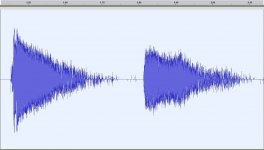
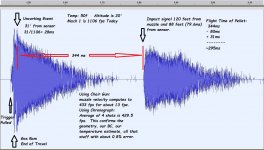
Now lets have a look at the first 25ms of the shot and see what we can figure out since we have apparently located the "uncorking event" correctly.
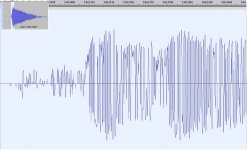
That sounds like this:
If you listen closely at high vol you can hear both peaks. They are about 1/100th of a second apart. The first peak is piston slamming home and the second is the uncorking. Well I can hear it in "Audacity" but not when I listen to it from the site. I will slow it down to 1/10 speed here:
We located the uncorking by computing muzzle velocity and flight time, but how do we know the first peak here is the sound of the piston hitting home and not the sound of the pellet exiting the barrel (inside the shroud)? We know the muzzle velocity ~430 fps. The distance between the end of the barrel and the end of the shroud is 4 inches. The pellet is traveling at the muzzle velocity when it exits the barrel so it travels that 4 inches in about 0.77 milliseconds.
The time between the two peaks is about 7 or 8 milliseconds. This is an order of magnitude too large to be timing that gap. No it is the piston striking the end of the travel and the time between the peaks is pellet acceleration to the end of the barrel PLUS the 0.77 milliseconds which it took to traverse the inside of the shroud.
The uncorking occurs at 771 samples into the shot, including trigger pull. We are sampling at 44100 samples/sec. 771/44100 = ~0.0175, about 17.5 milliseconds. That's a long time to get that pellet out the barrel and that's one reason springers are hard to shoot. We can estimate the sample at which the pellet left the muzzle and entered the shroud as well. 0.00077 * 44100 = ~34 samples. 771-34 = 736 samples so I will mark those:
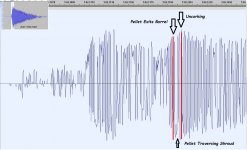
It looks like the pellet starts moving around 10 ms into the shot cycle? How do we know this? Well we know that there are two peaks (we can hear them) we know that the first peak can not be the sound of the pellet exiting the barrel because it occurs far too early. What is the loudest sound the rifle makes before the pellet exits the muzzle? Yep, got it in one! Well done! That peak is the piston hitting the wall and it is just about exactly at 10 ms. I will mark that and the barrel travel time.
Well done! That peak is the piston hitting the wall and it is just about exactly at 10 ms. I will mark that and the barrel travel time.
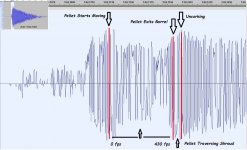
It looks like that pellet is accelerating for about 328 samples and this calculates to about 7.4 ms. That brings to us the question, "What then is the peak circled in yellow in the next image?
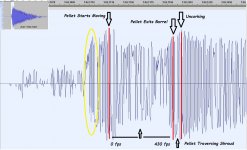
That peak starts ramping up at about 350 samples (8 milliseconds) into the shot. It is about 100 samples before the beginning of the movement of the pellet so call it 2 ms. It is the sound of the strut being released by the trigger mechanism. After that you hear the strut pushing the piston.
Here is the finished analysis.
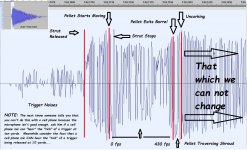
So using Audacity:
Mind you, that analysis is approximate, not exact. It is probably off a millisecond or two here and there. There is no substitute for good hardware triggers and analytic tools BUT if you can't get them, don't quit. Figure it out. Your brain is better than the best tools and that's true for every single one of us.
Lets have a look and listen to the shot.


Now lets have a look at the first 25ms of the shot and see what we can figure out since we have apparently located the "uncorking event" correctly.

That sounds like this:
If you listen closely at high vol you can hear both peaks. They are about 1/100th of a second apart. The first peak is piston slamming home and the second is the uncorking. Well I can hear it in "Audacity" but not when I listen to it from the site. I will slow it down to 1/10 speed here:
We located the uncorking by computing muzzle velocity and flight time, but how do we know the first peak here is the sound of the piston hitting home and not the sound of the pellet exiting the barrel (inside the shroud)? We know the muzzle velocity ~430 fps. The distance between the end of the barrel and the end of the shroud is 4 inches. The pellet is traveling at the muzzle velocity when it exits the barrel so it travels that 4 inches in about 0.77 milliseconds.
The time between the two peaks is about 7 or 8 milliseconds. This is an order of magnitude too large to be timing that gap. No it is the piston striking the end of the travel and the time between the peaks is pellet acceleration to the end of the barrel PLUS the 0.77 milliseconds which it took to traverse the inside of the shroud.
The uncorking occurs at 771 samples into the shot, including trigger pull. We are sampling at 44100 samples/sec. 771/44100 = ~0.0175, about 17.5 milliseconds. That's a long time to get that pellet out the barrel and that's one reason springers are hard to shoot. We can estimate the sample at which the pellet left the muzzle and entered the shroud as well. 0.00077 * 44100 = ~34 samples. 771-34 = 736 samples so I will mark those:

It looks like the pellet starts moving around 10 ms into the shot cycle? How do we know this? Well we know that there are two peaks (we can hear them) we know that the first peak can not be the sound of the pellet exiting the barrel because it occurs far too early. What is the loudest sound the rifle makes before the pellet exits the muzzle? Yep, got it in one!

It looks like that pellet is accelerating for about 328 samples and this calculates to about 7.4 ms. That brings to us the question, "What then is the peak circled in yellow in the next image?

That peak starts ramping up at about 350 samples (8 milliseconds) into the shot. It is about 100 samples before the beginning of the movement of the pellet so call it 2 ms. It is the sound of the strut being released by the trigger mechanism. After that you hear the strut pushing the piston.
Here is the finished analysis.

So using Audacity:
- we calculated the muzzle velocity of our rifle.
- located the "uncorking" event.
- identified and located the signature of the piston bottoming out.
- identified and located the signature of the piston being released.
- and measured the "trigger time" (8ms) and "lock time" (17ms) of a BSA Lightning XL GRT .25 shooting 31 grain 'cudas.
Mind you, that analysis is approximate, not exact. It is probably off a millisecond or two here and there. There is no substitute for good hardware triggers and analytic tools BUT if you can't get them, don't quit. Figure it out. Your brain is better than the best tools and that's true for every single one of us.
Last edited: